How to Price Your Online Course: The Definitive Guide (Updated for 2025)
6 comments
6 comments
You’re creating courses to make money for your business right?
Good, just checking.
If you are going to maximize your revenue (and profit) from creating and selling courses, then you absolutely need to price them correctly.
Pricing is a common pitfall for many first-time course sellers (and even experienced course sellers).
Like any product you sell, if your price is too high you will scare off your target market and if your price is too low then you are leaving money on the table.
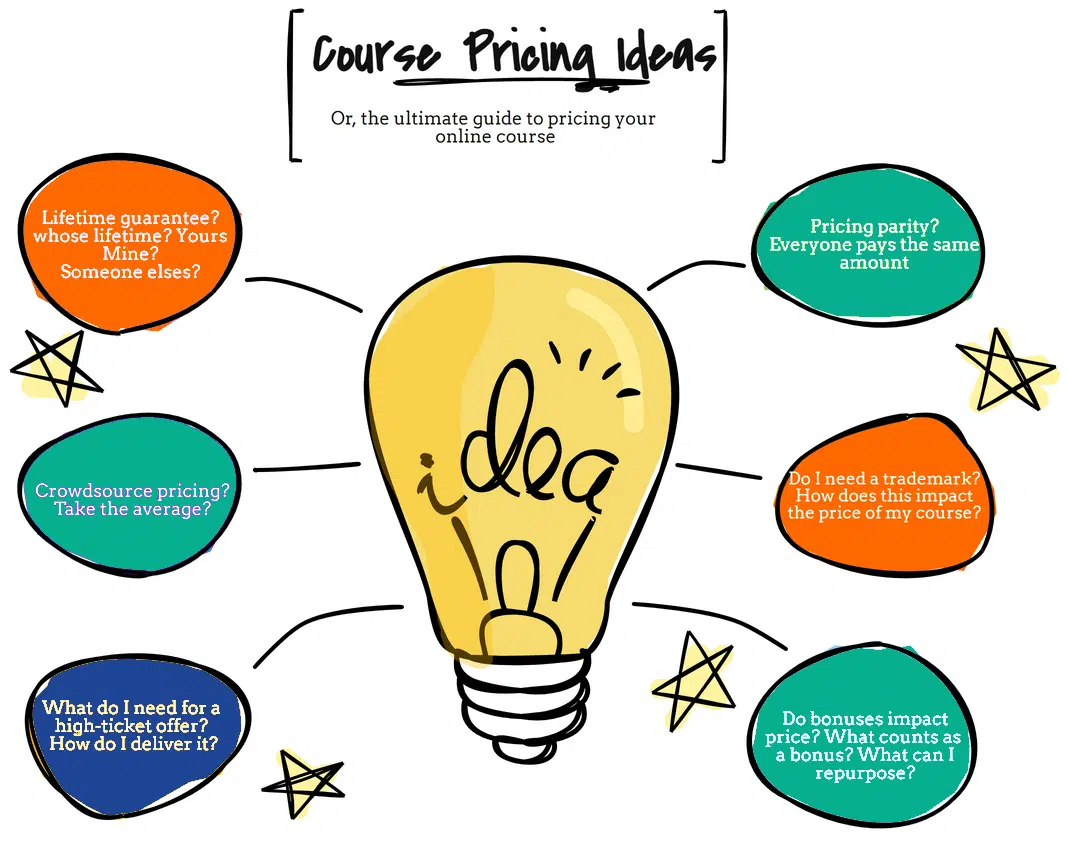
Most people err on the side of pricing too low. Pricing is a mix of art and science, and getting pricing right can take years of trial and error. You don’t have years though, so in this article, we will walk you through the process of pricing your courses to optimize your sales and profit.
This is a complete course pricing guide, so the post will take time to read and digest. If you are in a rush, bookmark it and download the mini-workbook now, and implement your course pricing strategy right away!
Let’s face it: creating a course is hard work and you deserve to get paid!
Think about it: to create a course you need to choose a course topic, map out a course structure, create your course content, build an audience, and build a sales funnel.
That’ll take quite a bit more than an afternoon (or a day) of work!
There is a serious temptation to under-price your course with the reasoning being that a lower price makes for an easier sale. While that may seem logical, the root cause of this line of thinking lies in a lack of experience and insecurity. Price sends an important signal to your potential buyers, so if you price too low you run the risk of sending a message that the course is not worth all that much.
If you’re tempted to under-price your course, hang in there with me for a second. Imagine for a moment what your business would feel like if you sold 10 courses a month. Imagine that those courses are $100 each. What would you do with the extra $1,000 each month? What difference would that make to your life?
A properly priced course will change not only your life but also the lives of your students.
What’s the right price? Well, pricing your courses involves many variables. In this guide, we’ll touch on the main ones so that you can work out the number that makes sense and works for you.
Price sends a signal to your prospective customer, but there is a lot more to pricing than what you would like to charge.
There are a series of factors that are worth taking into account when pricing your course. We’ll explore these a bit more later on.
You need to consider your experience
Your experience and brand are massive factors in how you price your courses. If you are a known expert, or at least can demonstrate expertise, then people will pay a premium to hear from you. Even if you do not have a book or never spoke at a conference do not let that downplay the professional experience you’ve built. It’s all in how you present it on your website and sales page.
Your target market will play a major role in determining the right price for your course.
If you are selling B2B the price point can be much higher than a consumer-level course. Businesses will spend a premium because they aren’t just buying the course, they are buying a solution to the problem the course solves.
Price sends a strong signal about the value of your course.
There is a difference in perception and value between a brief email course and a one:one walkthrough. If you are delivering a high-ticket offer with live elements, then you can charge a much higher price as the value will be that much greater.
Want to amp up the price? Here are some ways to add more value to an online course.
I’m going to ask you that question again…you’re creating courses to make money, right?
While helping your students and making an impact are important objectives for creating a course, making a profit is a nice one to have too. If you run a coaching or consulting business, you already know that you have limited time to take on new clients, so how much more money would you like to make from your course to supplement your client workload?
Knowing how much you want to make allows you to work backward to determine how many courses you need to sell by price point. For example, suppose you want to make an extra $10,000 this year from selling courses, that could be:
Knowing your goals for the course, and your business, can be a big help in determining the right price.
A key principle of making a profit is to make more in revenue than you spent.
That’s just Business 101. We all know this, especially if you’ve already built a business. You would be surprised though how many hidden costs go into creating a course, especially if you have not created a course before.
We’ve written a complete guide to estimating the cost of creating an online course, so check that out for the full walkthrough. Many factors can influence the cost of your course (and therefore, the price you should set). These factors are:
Labor is by far the biggest cost driver (especially if you keep software and hardware light). The cost of labor will depend on whether you are willing to take it on or outsource it. Depending on the size of the course and time investment, you could be looking at anywhere from $500 to $5,000 to create an online course.
Knowing that you can work backward to estimate what your breakeven point will be based on the number of sales you expect to make and the price you set for the course.

The worst pricing advice in the world is to find 10 competitors and price your course right smack-bang in the middle.
Yes, you should look at the competition to see what they are selling similar courses for. Do this for validation, not to set your price. You are not your competition. Your course isn’t comparable, so you cannot price it the same.
Your competitors may have a different audience or different experiences. They may be just guessing at their price too. Why follow them when you can go off your expertise and understanding of your customer?
Price your course for your audience of ideal customers and not your competitors.
By now you have the basics of course pricing theory and have hopefully overcome a few fears holding you back from building a new growth channel for your business.
I know pricing is complicated so you shouldn’t feel like you need to be an expert just yet.
That’s why we are going to walk through four possible price points and the course you can sell for each of them. These are based on our expertise (have we mentioned we sell thousands that you can re-sell?), so we know that these are realistic prices for the offering.
A low ticket offer is a course that would likely fall under a $20 - $49 price point.
This course is one idea / one challenge, with one solution. It’s the tentative first step to working with you. It’s the test you have to pass for your students to become regular customers and buy more of your courses.
Your student doesn’t expect a huge course at this price. 3-5 videos are the perfect amount of content or a 30-page ebook.
You may have a worksheet or a course guide. But your audience doesn't necessarily expect that amount of content at this price. If you add them as a bonus they’ll be thrilled and appreciate the extra value you’re sharing.
Case studies are also a good bonus here as they help your students understand how your course can help them.
Low ticket offers should be delivered in a way that is easy for you to manage at scale while still delivering a solid customer experience.
Options for delivery include:
Given the low cost of entry to set up a course using a tool like New Zenler, there's no excuse for a poor delivery experience.
Branding can be minimal at this price point if you don't have any (yet). Branding helps deal with content thieves and reinforces what you stand for, so include it where you can on all your course content.
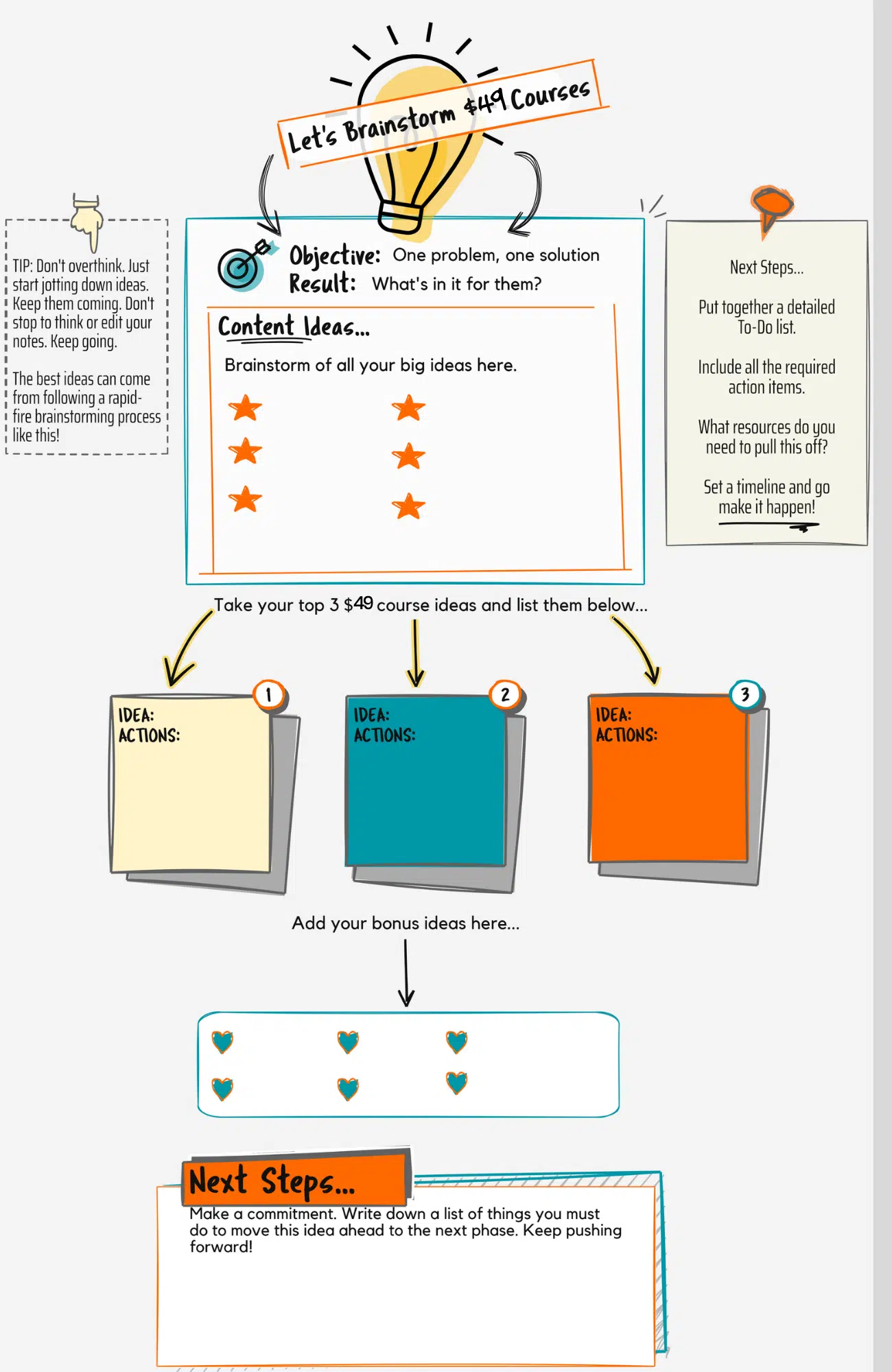
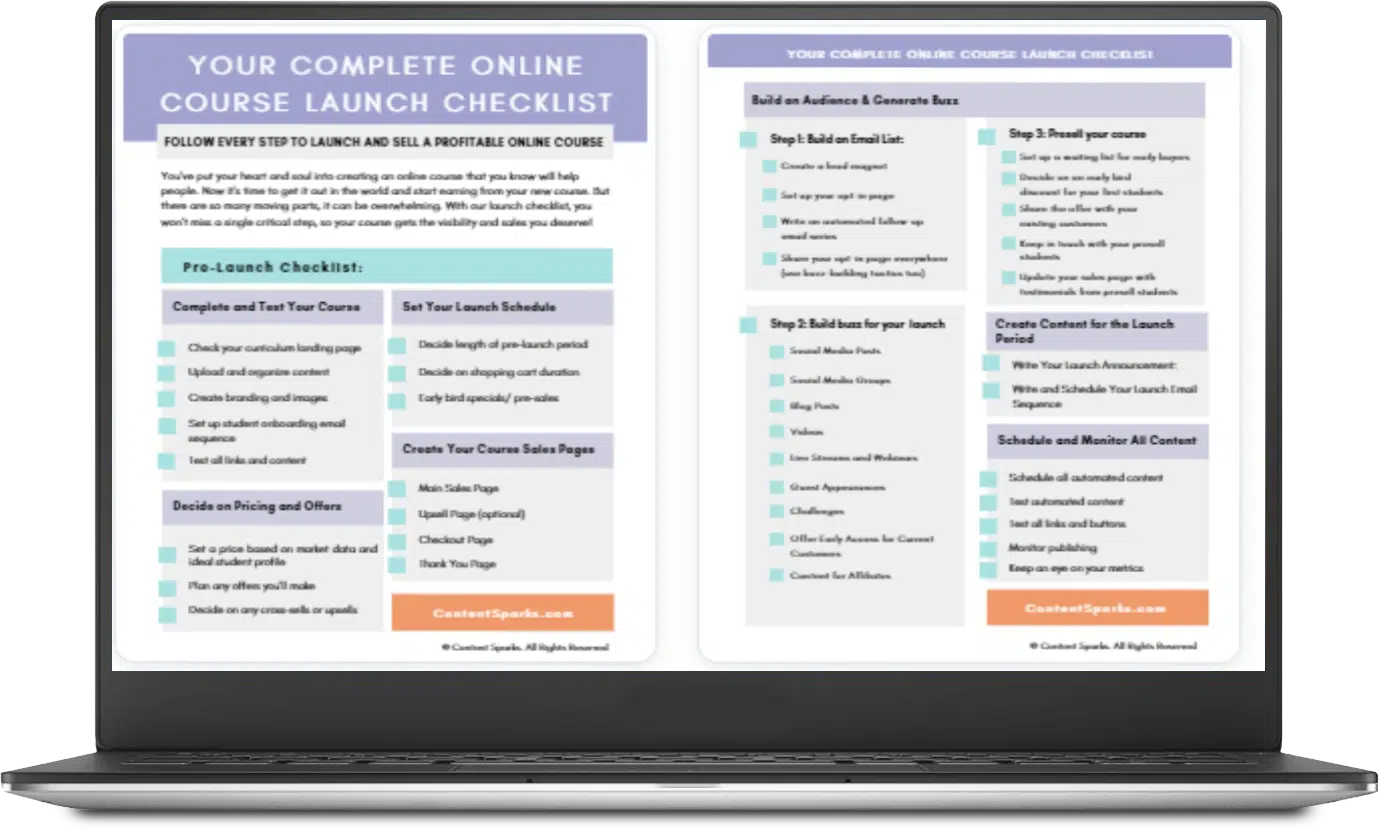
FREE Course Pricing Workbook
Want your own Course Pricing Workbook to decide how much to charge for your online course?
When you bump up a price point to the $50 - $99 range, courses get a bit more complex while still being affordable.
As the investment into your course is a little higher here, your students will expect more from you in terms of content.
You’ll have more videos - maybe 10 to 15. You’ll be expected to have specific learning objectives and key takeaways for each section or module of your course. Again, this is a one idea / one challenge and one solution course.
The content in a course at this price point is often the big-picture content. It's not the deeper, instructional how-to content unless it's very specific. For example, you may have an SEO course like our SEO Master Class where you give the big picture of SEO with many takeaways and action steps. Or, you could take out one section and dig deeper - like how to optimize blog posts or how to obtain backlinks.
I recommend you have 3 to 5 bonuses here, such as easy checklists, cheat sheets, and visual guides (infographics saved as PDFs are perfect). You might already have some lead magnets or quizzes that you could repurpose into bonuses.
Similar to the low-ticket offer, these courses can be delivered over email, direct link, or a Facebook group. The best practices still apply, poor quality audio and unlisted YouTube videos are a no-go.
Teach Yourself. Then teach your audience.
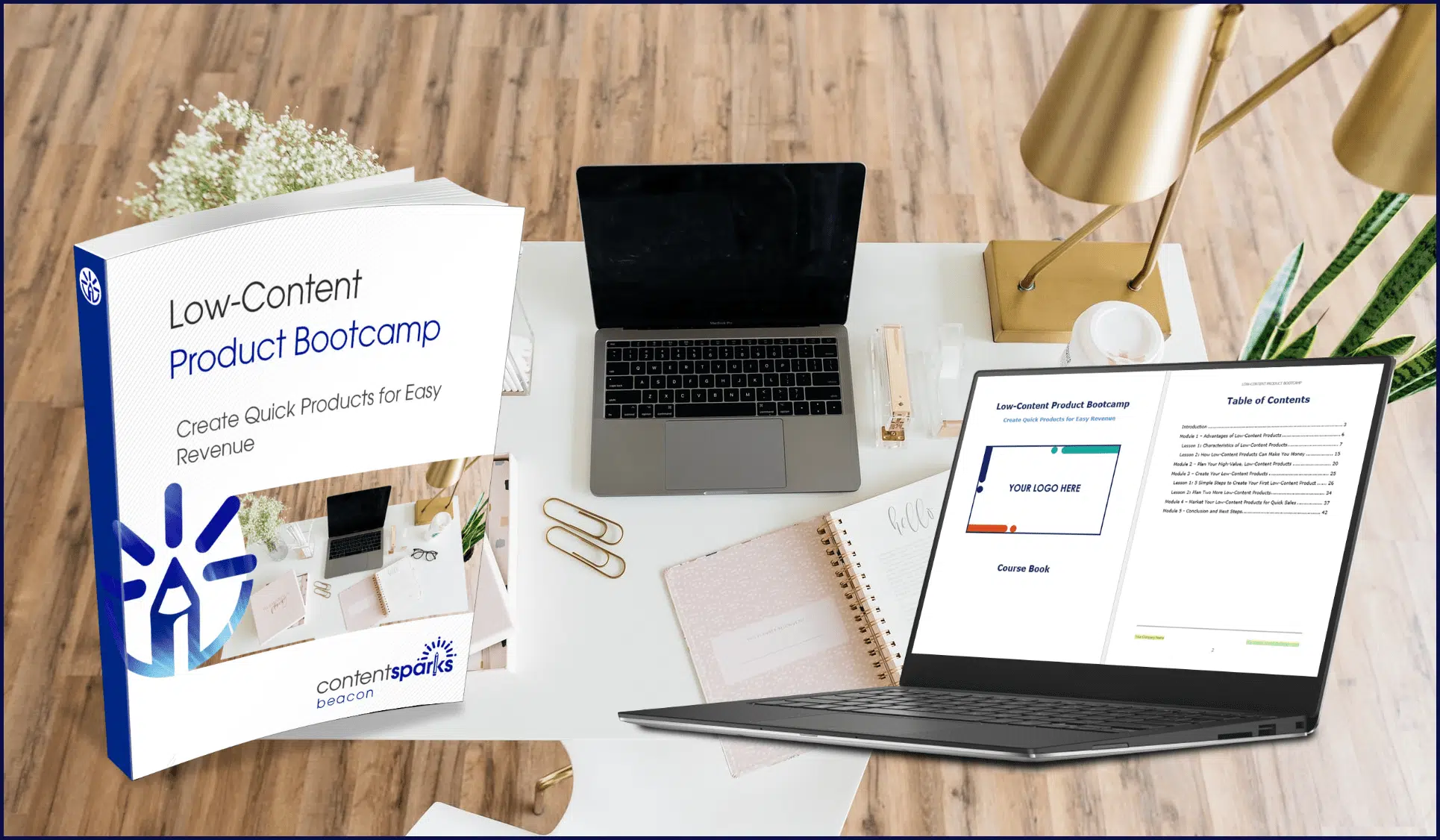
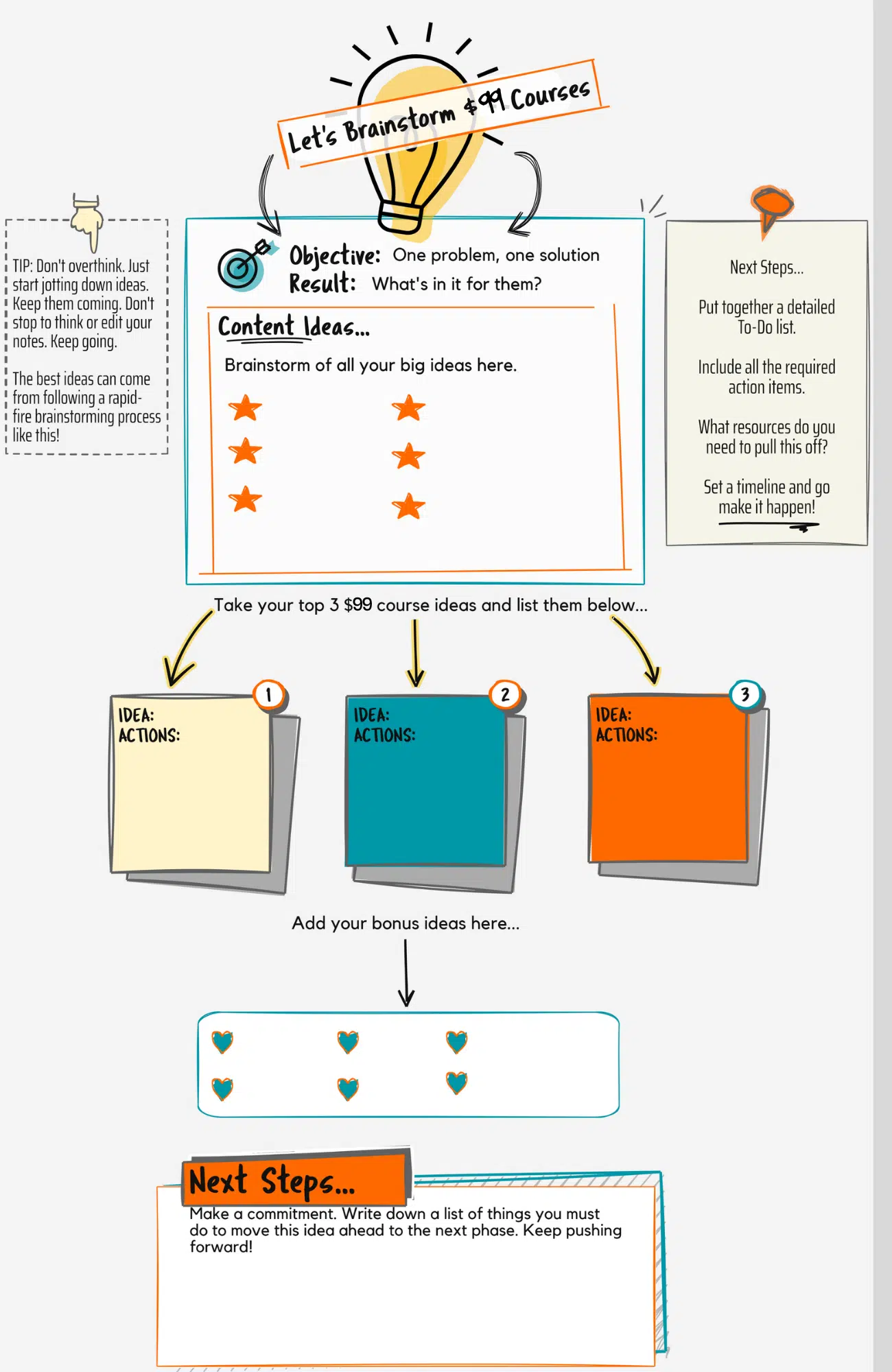
At this price point, your audience isn’t looking for the big picture or one small problem/solution. They’ll look for a more comprehensive solution to a bigger issue than the one you solved with the low-ticket offers.
If you are going to sell a course for $100 - $499, it needs to be a bit more involved than a couple of how-to videos.
Courses of this caliber will include:
At this price point, your audience wants a tangible, actionable solution for their investment. Your students will also expect transcripts of video and audio content. 3-5 bonuses are good here, potentially packaged together in a mini-course ($27 -$47) as well as audios, transcripts, and interviews with related experts.
If you are going to sell this course for up to $499, then you might find it beneficial to add in some live Q&A sessions with your students.
Journals and planners make a nice bonus too. If you use a print-on-demand service, you can send a planner directly to your new student. Having a branded piece of content on their desk is very powerful.
Due to the higher caliber of these courses a private membership space is preferred. This creates a feeling of exclusivity and safety. Because you deliver your content in a learning management system (LMS) you are seen as more professional. This gives your courses a better feel and overall experience.
At the lower end of the investment scale, a Facebook group is acceptable. Groups are great for live Q&As, but people also like the intimacy that a Zoom Q&A provides. You can poll your students and find out what they prefer.
Your content should be branded. This helps with piracy and intellectual property theft. Your videos should have your logo at the top. Your PDF content should link to your membership area, and your audio content will benefit from branded intros and outros.
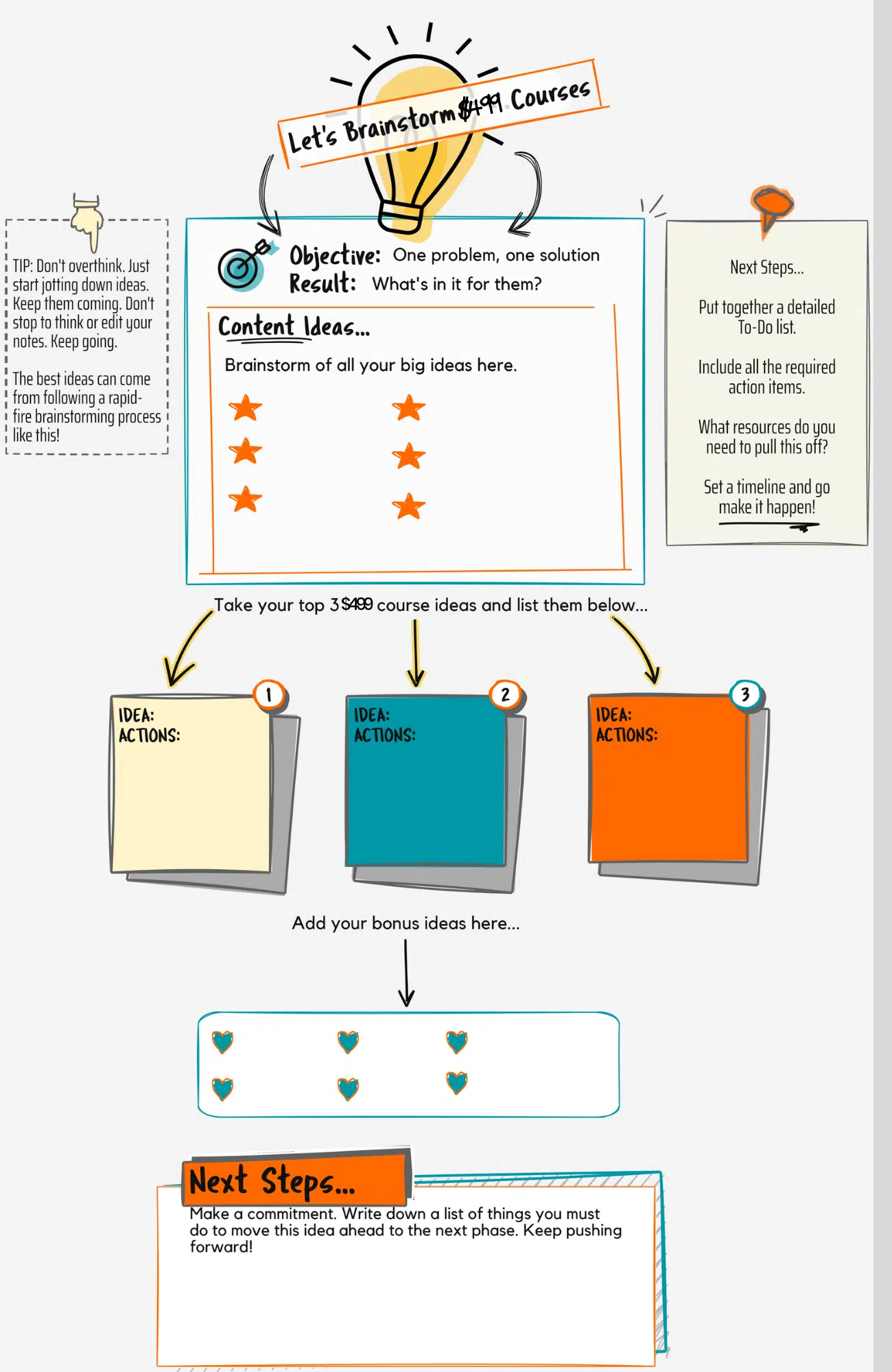
At this level, value is added through direct contact with you as well as the thoroughness of the material you present.
At this price point, your audience will expect some live interaction with you. Video content alone will not sell your course for you. Students want to interact with you at this point more than at any other level. This may be in the form of live Q&As, personal coaching, group coaching, or even live training. This is your most advanced information. Your audience is anticipating deep transformations and needs your support to achieve their goals.
Your content may be intensive, as in it’s delivered over 2-3 days, or it may be a 6-week experience. It’s up to you.
The bonuses here are also bigger. There may be bigger courses that are related that will help your students that you sell for $297, and you’ll use these as bonuses. Ebooks, wipe files, and templates tend to be expected as part of the main program and not as a bonus,
Spreadsheets, calculators, and interviews make a great bonus at this level.
Due to the higher caliber of these courses a private membership space is preferred. This creates a feeling of exclusivity and safety. Because you deliver your content in a learning management system (LMS) you are seen as more professional. This gives your courses a better feel and overall experience.
At the lower end of the investment scale, a Facebook group is acceptable. Groups are great for live Q&As, but people also like the intimacy that a Zoom Q&A provides. You can poll your students and find out what they prefer.
Your content should be branded. This helps with piracy and intellectual property theft. Your videos should have your logo at the top. Your PDF content should link to your membership area, and your audio content will benefit from branded intros and outros.
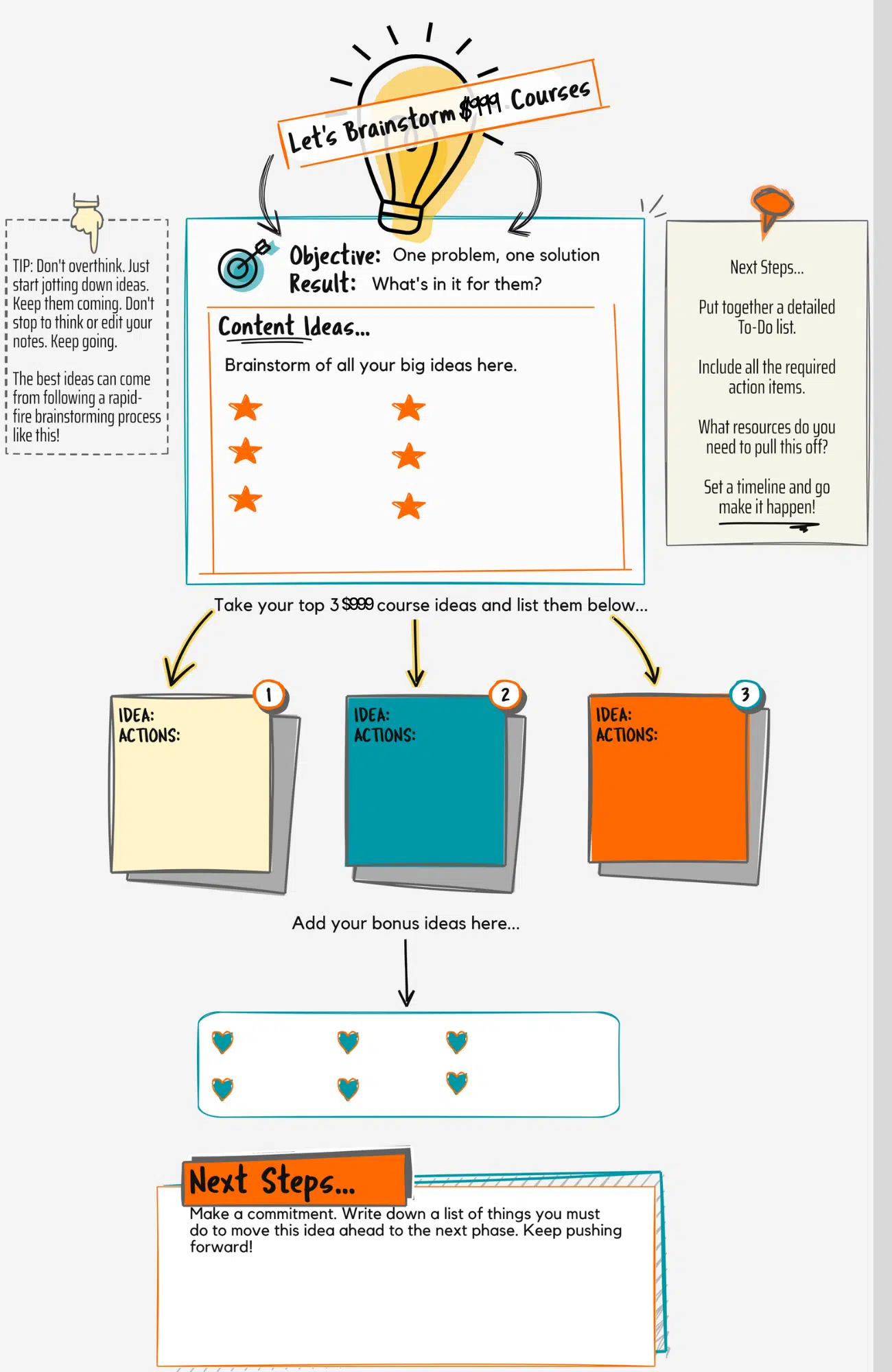
At this level of investment, your student wants shortcuts and fast tracks to their outcome; anything that accelerates their results should be included in the course with the bonuses so mouth-watering they’re clamoring to pay you.
Course materials can be sent via a print-on-demand service, and there are group sessions. At this level, your students want to network with each other. For them, it’s part of the reason they invested in a high-ticket offer: to meet like-minded people.
Often, a high-ticket offer includes an in-person event such as a mastermind day or a ticket to their seller's next in-person event.
Bonuses at this level are designed to make a “yes” easy. They could be:
How to deliver a high-ticket course
A community is desirable, but not everyone enjoys Facebook. If your LMS has an app, use it. Otherwise, look into tools like Mighty Networks or others that integrate with your online course platform.
A Facebook group for Q&A is acceptable, but an app is better. And for a higher-ticket course, it's not acceptable to use a Facebook group for content delivery. You need your platform.
Zoom delivery is acceptable so long as you have the replays hosted in your LMS (course platform). At this level of investment, not having the replays available is poor etiquette and could be seen as laziness. At this level, people are cash-rich but time-poor.
If you have in-person events included, you must ensure that those who received this as part of their course investment feel special.
No matter what level your student invests at, they should always know the boundaries and rules. If you offer a group for questions and keep getting messages from students with questions, you need to gently send them to your group or your support team.
Support and rules/guidelines should be made available to all your students.
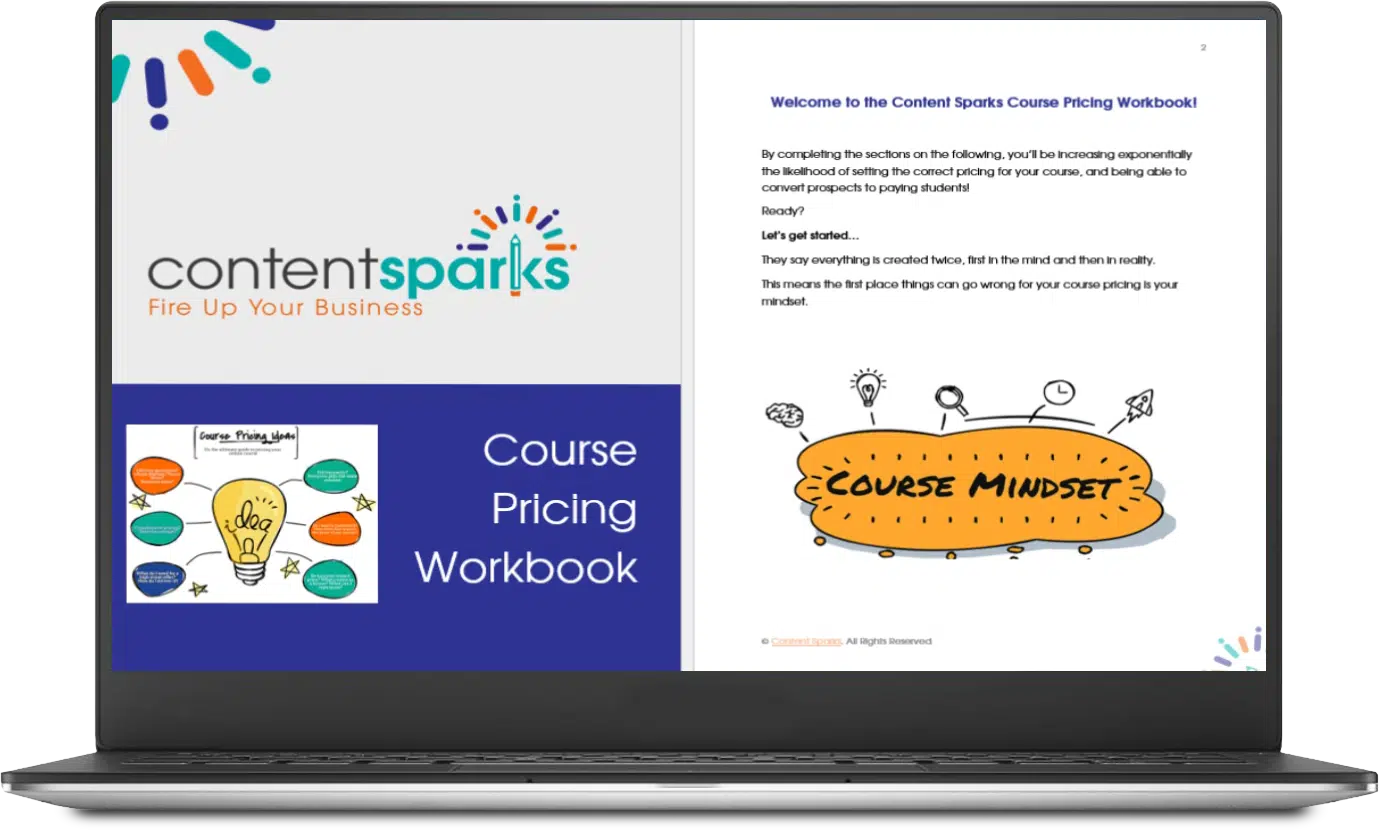
The Ultimate Course Pricing Workbook
Use this workbook to take action with your online course today!
We’ve covered how to price an individual course, but what about a curriculum?
When you hear curriculum you might think of a college-level course but don’t worry we don’t mean that. A curriculum is a series of courses on a specific theme. For example, if you are teaching a sales training you could run a curriculum made up of training on essential sales skills, cold calling, overcoming objections, and writing proposals.
These courses make up our sales curriculum. There’s still room to add things in, but enough content to teach an intensive for four weeks or spread it out over four months. You’ll need to schedule time for Q&As, coaching, and support. This is almost always a high-touch experience hence the higher price point.
Because of how comprehensive and involved a curriculum is, you can charge much more than a single course. You can charge as little as $1,000 depending on the target audience, delivery, and impact provided but you could sell a curriculum for as much as $5,000 or $10,000.
Now that you’ve chosen a type of course to create, and a price point to sell it at, how do you determine your profit?
The classic profit equation is profit = revenue - cost, though there’s a bit more to it when calculating the profit of selling a course.
We covered cost earlier in the post, so remember that three costs go into creating a course:
Hardware and software are generally “fixed costs” in that they do not change (though they can if you decide to improve the setup you use to create your course). Labor is the variable cost. The more involved the course the more labor that will go into it and the more it will cost.
A simple low-ticket offer may cost you around $500 to create. At a $49 price point, you need to sell 11 to break even. These are easier courses to sell, so you very well could sell 100 and end up with a $4,400 profit.
Meanwhile, a boot camp could cost you $5,000 to create, but at a $1,998 price point, you need to sell 3 to be profitable. That said, with such an intense offer you would likely want to make more profit than that so you may want to target 10 sales which would result in a $14,980 profit.
Depending on the type of course you create, the price, and how many sales you expect, your profit will vary. Fortunately, we created a handy calculator that you can find in our Course Pricing Workbook to help you input the cost to create your course, as well as the expected profit at different price points and sales estimates.
Here’s what it looks like:
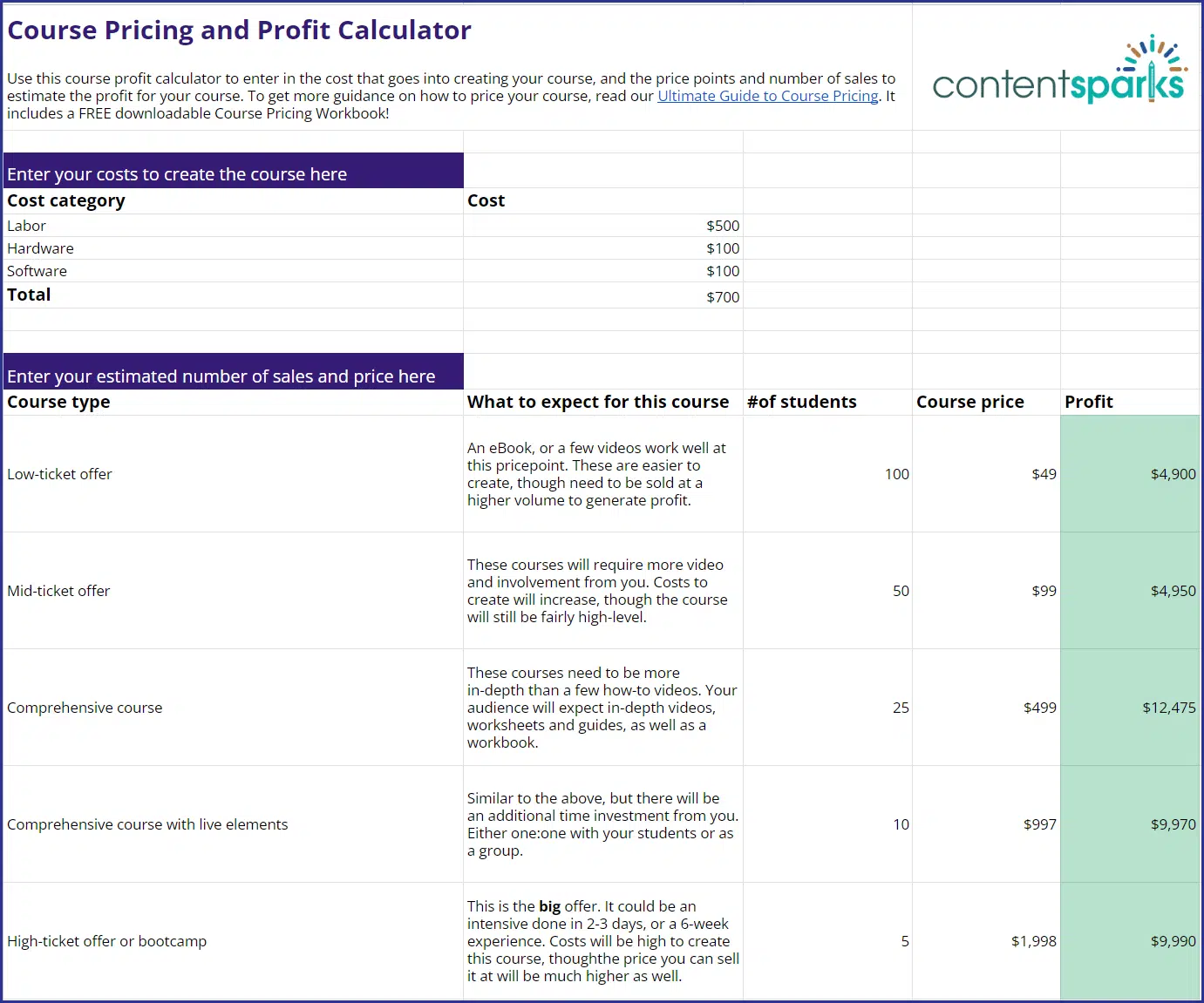
When in doubt, trust science!
There’s a psychological process happening when your students review your sales page and see the price - and there’s a way to influence that process in your favor.
Ever notice how prices often end in “.99”? That’s a subtle trick to stop you in your tracks by making you think the product is much cheaper than it is. This is a common tip that often works well, but here are a few others to bear in mind:
Next, let’s look at the most common excuses I see people make for pricing their courses too low.
It’s worth repeating: do not give in to the temptation to underprice your course. There are 7 excuses we find are quite common, so let’s dispel them now.
Even if you believe these statements, none of them are reasons to charge less than you're worth. Every online course creator and every education-based business owner has said these things at some point in their career. The difference is that they push through to overcome their excuses and become successful. You will too.

Meet Seneca, a toga-wearing male from 2,000ish years ago who said some very true things about teaching…
If you are capable of learning, then you are capable of teaching. It doesn’t matter what topic. All that matters is you can learn. If you're reading this, you're already learning and have the skills you need to teach.
Opportunity, luck, and preparation are all it takes to teach. If you think any differently, you’re just making excuses not to make money.
You’re not the first course creator to think this, and you won’t be the last.
It’s simply not true. Visit Udemy and type in your course topic. Skim through to see how many people are already buying what you teach. Visit Amazon and see how many books there are on the topics you wish to teach. See how many reviews there are for the books.
Your audience is there, and they’re already buying. Your audience needs to know, like, and trust you to buy. So get out there and get known!
We’ve all had moments of imposter syndrome from time to time. That’s where you think you’re not good enough, or you’ll be found lacking in some way.
The healthy way to look at it is to remember that everyone better than you also started where you are right now. So you can be successful selling courses because they’ve blazed a trail for you. You no longer have to pave the road as you build your business!
Of course, they can. They can also look up anything on Google or in their local library. It doesn't mean they will, and it doesn't mean they won't buy from you.
People pay for convenience. They pay for the golden nuggets not commonly known. Students pay for your attention and your insights. Sure, they can get them from a book or a video, but nothing beats the real thing!
Just because it's easy for you, it doesn't mean it's easy for everyone else. Most things are easy when you know how. Blogging is easy when you know how. List-building is easy when you know how. Writing a book is easy when you know how…
But when it's all new to your audience, it's not easy.
It may be easy because you have a great system to get it done, or you know how to hire the right people. You make it look easy because of your experience. And people love to know what you do and how you do it. They may choose not to do it, but they love the experience of watching you teach a skill.
If your course will sell with ads, but you don’t know how to run them or don't have the budget, that's just another excuse not to price your course properly.
Your course will sell in other ways. Most course creators validate their pricing and make a few early sales on social media, proving their course is viable. Ads are not essential to selling courses. If it sells with ads, it will also sell in other ways.
Everyone starts with no testimonials. However, successful course creators will go and hustle for them. Ask friends to take your course and give you a testimonial in exchange for free learning. Always ask more friends than the number of testimonials you need. You’ll be surprised by the number of people who won’t complete a course!
We’ve covered the basics, but you probably have a few more questions racing through your mind. Here are a few of the top questions we’ve heard on course pricing and pricing strategy.
If you’re still not convinced you should charge as much as possible with your course, let’s get this question out of the way.
Unfortunately, there’s no perfect answer. You should consider:
If a course costs you $100 to make, then 10 sales at $10 allows you to break even! But wouldn’t it be better to make 5 sales at $50 and make a profit?
Lifetime access to a course usually provides immediate access to the course and continued updates. When it comes to offering lifetime access to your course, you first need to think about what lifetime really means:
And that's the problem with offering lifetime access. It's vague and leaves you open to a lifetime of potential legal troubles.
In your course's terms of business (aka T&Cs) you need to specify what lifetime means if you offer it, and what's the reasonable expectation.
Only if you wish to die poor and lonely, and possibly win a world record or prize for being the poorest coach on the planet.
Course availability impacts pricing. If something is high-end and available for a limited time, then the price of your course should be higher. If you offer lifetime access (and we recommend you don't), then this factor impacts how much you charge for your course.
91% of consumers according to a Harris Poll agree that a refund policy is an important factor influencing their purchasing decision, as reported by the New York Times.
Do you need a guarantee for your course? As always, it depends.
Suppose you run a marketing agency and are selling an email marketing course. You may feel that your target customers need assurance that the advice they get will work (or at the very least that their entire list won’t unsubscribe), and feel like a 14-day money-back guarantee will put them at ease.
It also depends on course deliverability. You might determine that as your course is delivered live, there's no refund policy, you might decide as it's digital there are no returns once it's downloaded.
You'll be extremely confident if it's from us, Content Sparks. Confidence in your content means you have a longer guarantee.
If you don't offer a refund policy how does that look to your ideal client?
They could think you have no confidence in your course. On the other hand, if you decide to offer a guarantee it would be good to gather proof that they have at least completed one module of the course. A lot of high-ticket offers ask for your first piece of course homework to be submitted and proof of action before they issue your money back.
Firstly, I have to confirm that I'm not a lawyer and that I've never played one on TV. What you're about to read is not legal advice, you must get that from a lawyer. Disclaimer finished.
Depending on where you are in the world will determine whether you are allowed to offer installments. For example, to offer installments in the UK, you must be licensed to offer credit by the Financial Services Authority. You are also not allowed to charge more for installment payments in the UK. For example, if your course is £200 but you offer 4 installments of £55, totaling £220.
You may be able to position that as £55 x 4 payments for a total of £220, or pay £200 with a £20 discount for paying in full. Again, check the laws for advertising and pricing in your own country.
In the USA, you are allowed to offer installments, and you are allowed to charge extra for this. However, you should strongly consider how this positioning looks. For example, will it look like you are punishing those less affluent for taking your course? For a better perception, position it as a discount for those who pay in full. Or you could offer additional bonuses for those who pay in full for your course, like an exclusive coaching session.
Phew! We've covered so much in this post. Most people find bookmarking this page for when you need the course pricing guide again is a big time-saver.
They also love this fantastic workbook we've put together to help you price your course for success, using the worksheets and information from this guide.
Would you like a copy of the course pricing workbook?
Just add your name and email address below and I'll send you a download link via email. Be sure to whitelist contentsparks.com so you don't miss it!
Click below to request your workbook.
Enjoy!

Tags
Comments are closed.
This article is spot on. Thank you for the complete overview. It was wonderful advice from the start to finish.
From start to finish this post was chunk full of great information. The use of Maslow Hierarchy really gave me a new take how his theory fits in helping us understand our customers buying motives. And the breakdown of course pricing is so useful. I hope this is something we will have an option to turn into a course.
Hi Cheryl! Not sure yet about putting into a course, but you should definitely use if for your own course pricing. I’m glad it was helpful 🙂
Exactly what I needed at exactly the right time. I'm new to all of this and pricing has been kicking me in the you-know-what. I don't want to underprice but I also want to make sure it's priced so my ideal clients are able to purchase my course.
The points here were so well-explained and I really appreciate the workbook you included.
Thank you!
I’m so glad it was helpful, Emjae! What course are you doing?
Thank you for the myth busting email.
This article is very useful for weighting up my options with pricing. This subject is the most difficult of all decisions